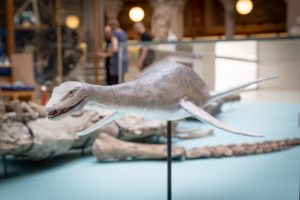Remains of a Plesiosaur found at Lyme Regis
Plesiosaur Fossil Discovery Announced
No sooner have record visitor numbers been declared for the Lyme Regis Fossil Festival, the Dorset town is back in the news again with the announcement of the discovery of a 70% complete plesiosaur fossil on Monmouth beach.
Plesiosaur Fossil
First the good news about the Fossil Festival, according to the organisers, an estimated 15,000 to 16,000 people attended the event, which was run from Friday 23rd May to the following Sunday. A number of team members from Everything Dinosaur attended and we are sure the excellent attendance figures were helped by the super Bank Holiday weather the Dorset coast enjoyed.
Now, the finding of a fossilised plesiosaur is a very rare event at Lyme Regis, occasionally vertebrae are found (they look like cotton reels), but to discover a 70% complete specimen including skull material is a find of a fossil hunter’s career. This is exactly what happened to Tracey Marler and her partner, keen fossil hunter Chris Moore on a visit to Monmouth beach to the west of Lyme Regis.
A close examination of the bones (which are in association and partial articulation), reveal teeth marks where the carcass was scavenged by another prehistoric animal. Plesiosaurs first appear in the fossil record from the Late Triassic, they were typically, long necked animals with small heads with jaws lined with needle-like teeth. The Loch Ness monster is regarded as a plesiosaur. It is believed these animals were specialist fish hunters (piscivores). The new discovery from Monmouth beach is believed to represent an individual that was over 4 metres long.
An Replica on Display in a Museum Similar to the Lyme Regis Plesiosaur
Picture credit: Everything Dinosaur
Richard Edmonds, Science Manager at the Jurassic Coast World Heritage site, stated:
“They [plesiosaurs] are rare. There are only ten known examples of complete or partial skeletons of this species. I have been doing this for thirty years and I have only ever found the odd bone”.
A Single Bone
Tracey and her partner Chris Moore, first found a single bone encased in the limestone rock, but they returned again and again to the location and were able to excavate about 150 vertebrae plus parts of the skull, the jaws and even a tooth.
To view a model of a plesiosaur, other marine reptiles and dinosaur toys: Prehistoric Animal and Dinosaur Models.
Commenting on their discovery, Mr Moore said:
“It came out in pieces but you could clearly see how it looked. The tail bone was in position. Some of the back bones were completely in place where they should be and the neck bones were there as well. You could see some of the bones had actually been chewed up a bit”.
It is not known what animal could have scavenged the carcass, but some scientists have speculated that it probably was another marine reptile, probably an ichthyosaur.
To see a scale model of an ichthyosaur and dinosaur models, take a look at the range of prehistoric animal models and figures in the PNSO section of the Everything Dinosaur website: PNSO Age of Dinosaurs Models.
Plesiosaur
Natural England worked closely with the Jurassic Coast World Heritage team to ensure the fossilised bones were extracted from their matrix, it is hoped the bones will eventually be put on display at the Lyme Regis Museum. A fitting location, as this building is very strongly associated with the famous Georgian fossil collector Mary Anning, the finder of the first plesiosaur fossils at Lyme Regis.


